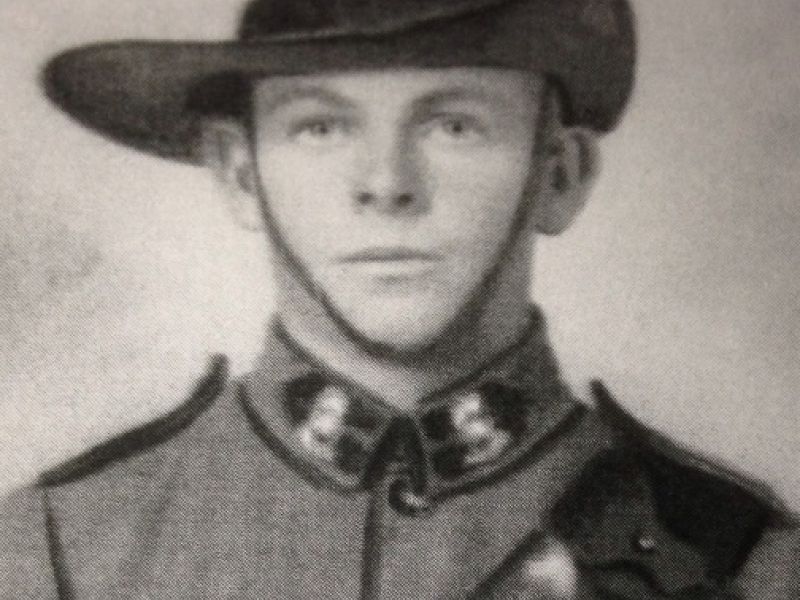Thomas John Clark
Thomas was born on the 5th of September 1893 at Apollo Bay on the south-west coast of Victoria. He was one of twelve children to Alfred Thomas and Elizabeth Francess (née Thompson) Clark. The family moved from the coastal town of Apollo Bay to the Wodonga area around 1894 where his father worked on the mines around Allan’s Flat. Thomas attended the Staghorn Flat State School.
Prior to the declaration of the war, Thomas had been a member of the 17th Albury Artillery Brigade. After resigning his position in this unit he enlisted in the AIF at Sydney on the 24th of August 1914, only twenty days after war had been declared. Due to experience in the 17th Battery, he was placed in the 3rd Battery, 1st Brigade, Australian Field Artillery and alloted the Regimental Number 358. At the time he was working as a horsebreaker in the district. He had gained a reputation as a very good horseman, capable of training and breaking in horses. The Army offered him a position as a horse breaker but he preferred to go to the front with his unit.
The battery embarked on HMAT A8 Argyllshire on the morning of the 18th of October, 1914, at Sydney. The war diarist wrote that the sea was rough as they left the safety of Sydney Harbour and as a result the majority of the personal suffered from sea sickness. Despite the heavy squalls there was work to be done in caring for the horses. This included cleaning out the stalls, exercising, feeding and rubbing the horses down.
On the 7th of December the battery disembarked at Alexandria and marched out to Mena Camp. For the next few months they trained in ernest focussing on standing gun drill, driving drill and signalling. Two and a half weeks before the landings on the Gallipoli Peninsula, the 3rd Battery embarked upon HMT A18 Cardiganshire, an English troopship. They arrived at Lemnos the following day. Over the course of the next week they practised carrying out methods of disembarking horses and artillery pieces using pontoons. Thomas’ role in the battery was that of a driver, rather than a member of one of the gun crews. There is no entry in Thomas’ service record stating that he joined the battery at Gallipoli so, along with others from the battery, it’s quite possible that he may have been left on Lemnos or even stayed back in Alexandria.
On the 23rd of March 1916, the battery sailed from Alexandria and arrived at Marseilles on the south coast of France on the 27th. He received a temporary promotion to Bombardier (the equivalent in the Infantry was Lance Corporal) on the 12th of September and this was confirmed a little over one month later.
Like many young men far away from home, Thomas made the most of his encounter with a different culture in a foreign land. His experiences would result in two long stretches in hospital, the first for 165 days and the second for 20 days. He rejoined his unit on the 19th of August 1917.
November of 1917 saw the 1st Field Artillery Brigade comprising of the 1st, 2nd and 3rd Field Artillery batteries and the 101st Field Artillery (Howitzer) Battery, situated about 10 kilometres north-east of Ypres. The area was being heavily shelled by the Germans. At 1725 hours on the 2nd of November the enemy commenced sending over gas shells. This particular bombardment lasted for about five hours. It was during this bomabardment that Thomas was wounded by gas. He was evacuated to the 3rd Australian Field Ambulance and then to the 2nd Canadian casualty Clearing Station where he succombed to his wounds. He was buried in the Lijssenthock Military Cemetery at Poperinghe, Belgium.
There were two main types of gas shells used by the Germans during the war; phosgene and ‘mustard’ gas. It’s most likely that the gas that killed Thomas was phosgene as it was far more deadly than the mustard gas, it being estimated that 85% of the 91000 gas deaths during WW1 were a result of phosgene or the related chemical diphosgene.
Thomas is remembered on the Australian War memorial Roll of Honour, the Wodonga War Memorial, and the Yackandandah Staghorn Flat State School Pictorial Roll. For his service during the First World War, he was awarded the British War Medal and the Victory Medal

 Stephen Learmonth
Stephen Learmonth